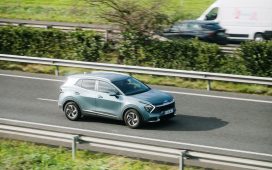The Albanese government has watered down flagship new laws aimed at disincentivising the use of high-polluting cars and hastening the importation of cleaner vehicles amid pressure from the auto industry.
On Tuesday the transport minister, Catherine King, and the energy minister, Chris Bowen, revealed the details of a compromise bill to be introduced to parliament this week, with the changes largely easing rules for popular large SUVs.
Australia’s proposed fuel standard will place a cap on the emissions from new cars to incentivise carmakers to supply low- and zero-emissions vehicles as part of their fleet. The cap will be lowered over time.
The government’s preferred model, unveiled in February, was expected to cut 369m tonnes of CO2 by 2050, while the watered-down standard will cut 321m tonnes by 2050.
The original plan set emissions targets for 2025 of 141 grams of CO2 per kilometre for passenger vehicles and 199 grams for light commercial vehicles, a category which includes utes and vans. These were set to be lowered to 58 grams and 81 grams respectively by 2029.
Under the “new vehicle efficiency standard” announced on Tuesday, the 2025 emissions target for light commercial vehicles will be 210 grams per km, and 110 grams by 2029.
The changes also recategorise a raft of Australia’s most popular SUVs – including the Toyota LandCruiser, Ford Everest, Isuzu MUX, Nissan Patrol and Mitsubishi Pajero Sport – from passenger vehicles to the light commercial category.
The government claims that due to these vehicles’ ladder frame chassis and braked towing capacity of more than 3 tonnes, they are more similar to utes and van. The majority of SUVs will remain classed as passenger vehicles as part of the changes, the government said.
Standing next to leaders from Toyota, Hyundai, the Electric Vehicle Council and Tesla, the ministers insisted the updated standard would still deliver about a 60% reduction in new passenger vehicle emissions and 50% reduction in new light commercial vehicle emissions by 2029, as well as $95bn in fuel savings by 2050.
The government also announced changes to the credits system. These mean companies whose emissions averages across their fleet come in below the cap will gain credits that can be traded with other manufacturers who will be penalised for exceeding the cap.
The government’s initial proposal for a rate of penalty of $100 per g/km of CO2 emitted over a manufacturer’s cap remains.
While the standard will still begin on 1 January, the government has also pushed out the effective start date of the credit and penalties system to 1 July. This is to “give industry more time to adjust” and allow more time to put in place the regulator and IT systems, the government said.
Bowen called the changes “sensible but long overdue”. “Not everybody here has got everything they’ve asked for; some people wanted us to go harder, faster, some had concerns and wanted us to slow,” he said.
Tesla’s Sam McLean said there had been “compromise between all the folks you see up here on stage”.
“This is a very moderate standard that takes Australia from being really last place in this transition to the middle of the pack, and it will save motorists thousands of dollars in petrol,” he said.
The car industry seems to have come to a somewhat amicable agreement with the government, with the Toyota boss, Matthew Callachor, saying the changes are not a “car tax” as claimed by the opposition.
In a press conference on Tuesday, the shadow infrastructure minister, Bridget McKenzie, and shadow energy minister, Ted O’Brien, repeatedly referred to the changes as as car tax, even after Callachor’s comments to the contrary were pointed out.
after newsletter promotion
McKenzie said the opposition had not seen the legislation but planned to vote against it.
Toyota had raised concerns about the standards going too far and affecting popular models such as utes and family cars, while the electric vehicle maker Tesla said the standard should go further.
Callachor said Toyota supported the amended scheme as a positive step, though he added: “We shouldn’t be under any illusions that there still remains a very big challenge in achieving those ambitious numbers.”
The Electric Vehicle Council chief executive, Behyad Jafari, said the new policy “represents strong, ambitious standards that will send a clear signal to the global automotive industry: Australia now demands the same options in electric cars, vans and utes that you offer to the US and Europe”.
The Climate Council chief executive, Amanda McKenzie, welcomed the compromise, saying: “Manufacturers have been dumping their dirtiest cars here for years, and that has got to stop.”
The Federal Chamber of Automotive Industries had called for the scheme to be watered down, a position that led to Tesla and Polestar quitting the group in protest.
An FCAI spokesperson called the changes “a step in the right direction.” “However, we continue to have concerns about the impending challenges facing industry and motorists.”
While the government and proponents including the Grattan Institute claimed that the standard would bring in more cheaper-to-run cars, the federal opposition and some sellers claimed the initial proposal would have increased the cost of some popular cars, including utes.
The changes follow the Biden administration last week announcing it would ease its rules – a scheme that the Albanese government had claimed it was basing its local standard on.
A new car sold in Australia uses, on average, 6.9 litres of fuel for each 100km compared with new cars in Europe and the US that use 3.5 litres and 4.2 litres, respectively.










